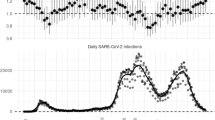Abstract
Introduction
The purpose of this study was to evaluate the rate of cholecystectomy before and after adoption of an emergency general surgery (EGS) model at our institution.
Methods
A longitudinal, observational study was conducted prior to and following introduction of an EGS model at our institution. Using the New York SPARCS Administrative Database, all adult patients presenting to the emergency department with gallbladder-related emergencies were identified. The rates of laparoscopic and open cholecystectomies performed 3 years prior and 3 years following the adoption of the EGS model were examined. A multivariable logistic regression model was used to compare the incidence of cholecystectomy at initial ED visit at our institution pre- and post-EGS introduction as well as to those in the rest of the state as an external control group, while adjusting for potentially confounding factors.
Results
There were 176,159 total ED visits of patients with gallbladder emergencies (154,743 excluding repeat presenters) in the studied period in NY State. Of these, 63,912 patients (41.3%) had a concurrent cholecystectomy in NY State. The rate of cholecystectomy at these institutions remained relatively steady from 38.8% from 2010 to 2013 and 38.6% from 2013 to 2016. At our institution, there were 2039 gallbladder emergencies, and of those 755 underwent cholecystectomy. At our institution, there was an increase from 28.21% 3 years prior to the adoption of the EGS model to 40.2% in the following 3 years (RR = 1.06, 95% CI 1.0164–1.1078, p = 0.0069).
Conclusion
The initiation of the EGS model at a tertiary center was associated with a significant increase in the number of concurrent cholecystectomies from 28.21 to 40.2% over a 6-year period. This change was accompanied by an increase in the number of patient comorbidities and a lower insurance status.


Similar content being viewed by others
References
Earley AS, Pryor JP, Kim PK et al (2006) An acute care surgery model improves outcomes in patients with appendicitis. Ann Surg 244(4):498–504
Shafi S, Aboutanos MB, Agarwal S Jr et al (2013) Emergency general surgery: definition and estimated burden of disease. J Trauma Acute Care Surg 74(4):1092–1097
Cubas RF, Gomez NR, Rodriguez S, Wanis M, Sivanandam A, Garberoglio CA (2012) Outcomes in the management of appendicitis and cholecystitis in the setting of a new acute care surgery service model: impact on timing and cost. J Am Coll Surg 215(5):715–721
Lau B, Difronzo LA (2011) An acute care surgery model improves timeliness of care and reduces hospital stay for patients with acute cholecystitis. Am Surg 77(10):1318–1321
Wang Z, Huang X, Zheng Q (2012) Single-incision versus conventional laparoscopic cholecystectomy: a meta-analysis. ANZ J Surg 82(12):885–889
Becher RD, DeWane MP, Sukumar N et al (2019) Evaluating mortality outlier hospitals to improve the quality of care in emergency general surgery. J Trauma Acute Care Surg 87(2):297–306
Udyavar NR, Salim A, Cornwell EE 3rd, Cooper Z, Haider AH (2019) Do outcomes in emergency general surgery vary for minority patients based on surgeons’ racial/ethnic case mix? Am J Surg 218(1):42–46
Shao LJ, Xue FS, Yang H (2019) Prediction of adverse outcomes after emergency general surgery in older patients. J Am Geriatr Soc 67(4):852–853
Acknowledgements
We acknowledge the biostatistical consultation and support provided by the Biostatistical Consulting Core at School of Medicine, Stony Brook University.
Funding
None.
Author information
Authors and Affiliations
Corresponding author
Ethics declarations
Disclosures
Gregory W. Kirschen, Maria S. Altieri, Suresh Yelika, Andrew T. Bates, Jessica Schnur, Salvatore Docimo, Konstantinos Spaniolas, Chencan Zhu, Jie Yang, Mark Talamini, Aurora D. Pryor and Samer Sbayi have no conflicts of interest or financial ties to disclose.
Additional information
Publisher's Note
Springer Nature remains neutral with regard to jurisdictional claims in published maps and institutional affiliations.
Rights and permissions
About this article
Cite this article
Kirschen, G.W., Altieri, M.S., Yelika, S. et al. Does the adoption of an emergency general surgery service model influence volume of cholecystectomies at a tertiary care center. Surg Endosc 34, 3064–3071 (2020). https://doi.org/10.1007/s00464-019-07052-x
Received:
Accepted:
Published:
Issue Date:
DOI: https://doi.org/10.1007/s00464-019-07052-x




